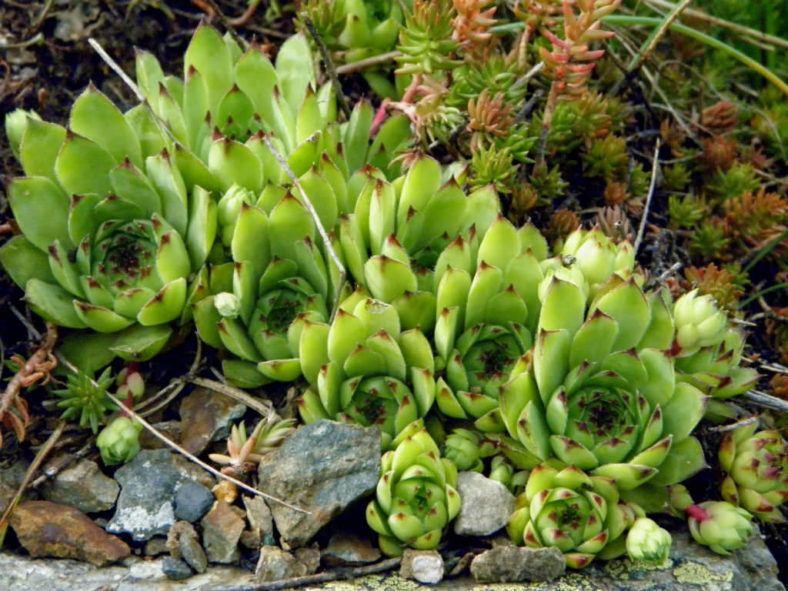The scientific name Sempervivum tectorum means "always alive on the roof," reflecting where this plant was mainly found in the past. It can still be found on the roofs of cottagers in rural Mid and South West Wales in the UK. If the Welsh have a Houseleek on the roof, they will want to keep it there as it is believed that if it is removed or picked by a stranger, bad luck and perhaps the death of one of the family will ensue. The Houseleek protects the house from fire and lightning, keeping household members safe and prosperous. It is also believed to protect the household against witchcraft. If the plant has to be moved, it will be safely transplanted to a rockery and used for stings. It has superb anti-inflammatory properties and relieves the pain of insect bites and stings virtually immediately. You might think it strange that it can grow on roofs, but in Wales, people in remote rural areas have roof gardens. From the road, you cannot tell there is a house under the garden, where typically daffodils, not leeks (the vegetables), grow.
The Holy Roman Emperor Charlemagne (742-814 AD) ordered all his subjects to grow houseleeks on their roofs, presumably to offer protection against lightning, as it was believed in ancient times (pre-Charlemagne) that the Houseleek was connected with Jupiter (the Thunderer) and with Thor, the Norse god of Thunder. Some of the names of the Houseleek are Jupiter's Beard (because the vast numbers of flowers were supposed to resemble Jupiter's beard), Jupiter's Eye, Bullock's Eye, and in Anglo-Saxon, Sengreen, Ayran, and Ayegreen (meaning evergreen). In German, it is called Donnersoart (Thunder Beard).

The Houseleek is native to Central and Southern Europe and the Greek islands and is known as the Common Houseleek. It is believed to have been introduced into Britain by the Romans, like the Wild Rose or Dog Rose, as it is called. The flowers have no perfume, but bees and butterflies love them.
The botanist Linnaeus mentions that in the 17th century, the Swedes used to grow it on their roofs because it helped preserve the thatching materials used.
The word "leek" comes from the Anglo-Saxon word "leac," which means "plant," so the name means "house plant," and it was once literally in Roman households, as they used to grow Houseleeks in vases near their windows. Dioscorides says that the Houseleek should be used for weak eyesight and inflamed eyes. The plant's juice would be used to soothe the eyes. Pliny believed that the juice, if taken internally, would cure insomnia.
For centuries, the juice and leaves have been used in folk remedies for their coolant, anti-inflammatory, astringent, and diuretic properties. Bruised leaves of the fresh plant or its juice can be used as poultices for burns, scalds, ulcers, and other inflammation, as the pain is quickly reduced. Honey, mixed with the juice, helps relieve the pain of mouth ulcers. The juice can be used as a purgative if taken in large doses. According to Parkinson, it takes corns from the toes if the feet are bathed in the juice, and then the toes are wrapped in the Houseleek's leaves. He also said the juice could remove warts. Culpeper thought it was suitable for all inflammatory problems and that if the juice were made into a hot drink with honey, it would bring down the temperature of a fever sufferer. He went on to say that if a drop or two of juice were put into the ears, it would cure an earache. He also used it to treat ringworm, which, according to modern medical research, is also effective for impetigo. He also claimed that it "easeth the pain of gout." Another of Culpeper's remedies was applying the juice to the forehead or temples to relieve headaches. He also recommended that the bruised leaves should be put on the "crown or seam of the head" to stop a nosebleed. Gerard merely agreed with Culpeper and Parkinson.
The Houseleek was once used in Italy as a love charm. However, its use has fallen out of fashion.
Modern medical research has shown that the Houseleek contains carbohydrates, isocitric acid, citric acid, malic acid, malonic acid, free amino acids (asparagine), carbonic acid, phenolic acids, flavonoids, and mucilage. The flavonoids contribute to their anti-inflammatory properties. So, once again, modern scientists can confirm what the ancients and rustics have known for centuries.
Source: herbs-treatandtaste.blogspot.com
Links
- Back to genus Sempervivum
- Succupedia: Browse succulents by Scientific Name, Common Name, Genus, Family, USDA Hardiness Zone, Origin, or cacti by Genus